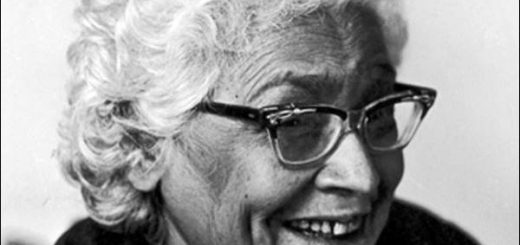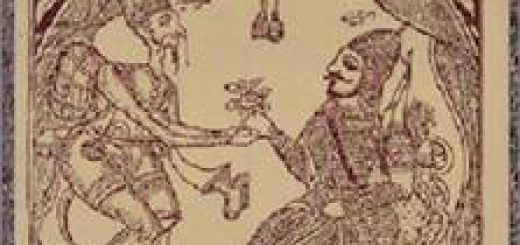Age of the Earth and Its Measures – By Mohammad Gill
Behold! In the creation of the heavens and the Earth; of the Night and the Day; in the sailing of the ships through the Ocean for the profit of the mankind; in the rain which God sends down from the skies, and the Life which He gives therewith to the earth that is dead; in the beasts of all kinds that He scatters through the earth; in the change of the winds and the clouds which they trail like their slaves between the sky and the Earth; (here) indeed are signs for a people that are wise. (The Holy Quran, ch. 2, v. 164)
At first, many people wondered just out of curiosity as to how old the Earth was. Or when did God create it? By and by as man’s mind became more inquisitive about the natural phenomena, such questions were not merely idle enquiries. The ideas of the evolution of the world and the life therein had started germinating although there were no precise ideas as to how it had occurred. The geologists had started observing the natural phenomena, which presumably had shaped the structure of the earth, more closely. Such inquisitive ideas invariably led to the question: How old was the Earth?
First Estimates of the Age of the Earth
In the pre-scientific world, the age estimates were based on the religious sources. In the Christian world, Archbishop James Ussher (1581-1656) of Armagh, Ireland, “calculated from the Bible (augmented by some astronomy and numerology) that the creation began on October 23, 4004 BC, “ (http://en.wikipedia.org/wiki/Age_of_the_Earth). He published it in a book in 1654, two years before his death. According to this, the world began some 6,000 years back. The people, including some notable scholars and scientists such as Martin Luther, Johannes Kepler, Isaac Newton, believed in it or a similar date. Many people till very recently and many creationists even now believe in it.
The Han Chinese believed in the cyclic creation of the world and they thought Earth is re-created after every over 23 million years. The Bible and Quran do not explicitly give the age of the Earth. The traditional Jewish calendar begins from 3760 BC, which is taken as the date for the creation of the Earth. Aristotle believed in the eternity of the world.
Sign Readers and the Skeptics
Edmund Halley (1656-1742), see Note 1, a prominent astronomer (of the fame of Halley’s Comet) observed:
� “Rivers are continually washing small amounts of dissolved salts into the oceans, so over time the oceans should get more salty.
� He then asked how much time it would take for an initially fresh-water ocean to achieve its current level of salinity.
� He argued that the Earth couldn’t be very young (few thousand years) because otherwise the oceans would still be mostly fresh water.
� Similarly, the Earth could not be infinitely old, otherwise the ocean would be thoroughly saturated with salt,” (http: astronomy.mps.ohio-state.edu/~pogge/Ast161/Unit5/deeptime.ht ml).
He however did not prepare any estimate of the age of the Earth.
William Smith (1769-1839) was a British civil engineer and a surveyor. He came from a lowly social background, which proved a great handicap to his professional life. He worked in the coal mines and constructing canals. He was a very observant person; in the mineshafts, he paid close attention to the exposed strata of the earth. He argued that these strata were formed by the deposition of the eroded material by wind and the flowing water. The top layers were recent and the deeper ones were old. He also noticed that the structure of these layers was similar irrespective of their geographical location. He had seen similar stratification in the excavated formations in the canals also. On closer scrutiny, he detected the remains of the older life, the fossils, in the layers. Wonder of wonders, the fossils in the upper layers were similar to the existing life while those in the bottom layers were entirely different and didn’t seem to correspond to any living beings. He argued that those species whose fossils were embedded in the lower strata must have become extinct. From this, he concluded that life on Earth was not created in one single act, as the Bible would have us believe. Secondly, the Earth must be much, much older than the current estimates of its age because the process of stratification is very slow. He was so much occupied by these thoughts that he earned the nickname of ‘Strata’; so he was called William Strata Smith. Many give him credit for founding the field of knowledge of fossils, which is called Paleontology.
He prepared the first national geological map of England, which was plagiarized by his rival and more influential peer, George Bellas Greenough, first president of the Geological Society of London. See Note 2.
Charles Lyell (1797-1875), known for writing an authoritative account of geology in his Principles of Geology, which ran through 12 editions, used the strata of different rocks to separate the ages of previous geological history, noted changes in fossil strata as ways to fix relative ages, and noted that the old rocks were like the young ones but life showed great variation with time. He introduced the idea of Stratigraphic Ages for geological formations, which are still used in modified forms.
He also introduced the principal of ‘uniformatarianism’, which states “that the development of the surface of the earth has been going on all through the ages without interruption, and that the process of very slow change that we observe today has been responsible for the present surface features of the earth,” (Norman Smith, “Millions and Billions of Years Ago: Dating Our Earth and Its Life). He argued that the features of earth are constantly changing by erosion and re-formation and the rate of this change was nearly constant. He proposed that this principle could be used to estimate the age of the earth although he did not give any estimate himself.
Charles Darwin (1809-1882) formulated his theory of natural selection based on his observations of fauna and flora in the Galapagos Islands. His theory required an extremely long time for life to evolve from lower forms to the present complex forms. Earth, in his view, could not be as young as tens of thousands of years; it had to be much older.
Scientific Estimates of the Age of Earth
Estimates from the Cooling of Earth
Earliest estimate of the age of Earth by its cooling process was given by the French naturalist the Comte du Buffon (1707-1788). He constructed a small globe that resembled the Earth in composition and then measured its rate of cooling. According to his calculations, Earth took approximately 75,000 years to cool down to its present condition. This was only a rough estimate and many didn’t pay much attention to it.
Later, the physicist William Thomson (Lord Kelvin) of Glasgow (1824-1907) worked on this idea more elaborately and published his calculations in 1862 giving the age of the Earth between 20 million and 400 million years. He assumed that initially the Earth was a completely molten ball of rock and computed the time for it to cool down to its present condition. Although 400 million years was a much larger age compared with the other estimates that had been proposed earlier using other, not so accurate, methods of erosion and deposition or the salinity of the ocean water, this did not quite fit with Darwin’s theory of natural selection, which required a much more ancient earth.
Darwin’s great advocate Thomas Huxley rejected Thomson’s estimate arguing that though there was no fault in his computations, his inherent assumptions were wrong. However, some other estimates prepared independently were nearly in the same range as Thomson’s estimate. German physicist Hermann von Helmholtz and the American astronomer Simon Newcomb calculated the time that the Sun would take to condense down to its present diameter and brightness from the nebula of gas and dust from which it was born. Their estimate was 100 million years. John Joly of the University of Dublin came up with an age of 90 million years using the accumulation of salt in the ocean from the erosion processes.
These estimates continued refining with the passage of time but a true revolution was heralded by the discovery of radioactivity in 1896 by the French chemist A. Henry Becquerel. Two other French researchers, Marie and Pierre Curie, discovered the radioactive elements, polonium and radium, in 1898.
Radioactivity and Radio-Chronometry
Age estimates based on the earth cooling process were not accurate due to neglecting a very significant parameter because nobody was aware of it at that time. This was radioactivity, which was discovered toward the end of the nineteenth century. The radioactive materials, which were discovered in air, in the soil, in rainwater, snow, groundwater and in the rocks emitted radiation which would warm the earth and counteract the assumed process of cooling. The rate of emission of radiation or the radioactive decay was constant for a given material and the parent material was transmuted to different radioactive lighter elements in the process by releasing alpha, beta, or gamma radiation. The decay rate was given in terms of a “half life”, which is the time taken for the material to transmute half of its mass by radioactive decay. The true phenomenon of radioactive decay was finally comprehended from the pioneer works of Ernst Rutherford, Bertram Boltwood, Frederick Soddy, Williams Ramsay, among many others. The radioactive material decayed through a series of lighter radioactive materials into the base stable metal lead. This was, so to say, alchemy in reverse. The alchemist had sought to convert the base metals into gold.
Starting with Uranium(238), for example, which is an isotope of Uranium with atomic weight of 238, it decays into Thorium(234), Protactinium(234), Uranium(234), Thorium(230), Radium(226), Radon(222), Polonium(218), Lead(214), Bismuth(214), Polonium(214), Lead(210), Bismuth(210), Polonium(210), and finally into the stable element Lead(206). Each one of these isotopic elements has a different half life.
In a given sample of rock, the proportions of the decayed elements are determined and used with their respective half-life to compute the age of a rock sample.
One of the problems encountered in computing the age by radiometry, was due to the existence of naturally occurring lead in the sample. Fortunately, this was easily resolved because the decayed isotope of lead is different from the naturally occurring lead so that they could be distinguished from each other. Another problem was due to the transient stage of Radon, which is a radioactive gas and might possibly leak out of the crystals of the rock. But this stage is only of a short duration. All these factors were taken into consideration and were duly accounted for in computing the age of a given rock sample.
In addition to the above-described methods, the potassium-argon method, the fluorine method and the paleogeomagnetic method are also used. The potassium-argon method is fairly common these days for dating the old fossils.
It was found that the age of the earth determined by using the radiometric methods was in billions of years. For instance, the oldest rocks in Greenland were dated by four independent radiometric methods and the age ranged between 3.7 and 3.8 billion years. The samples of the Moon rocks collected in the Apollo missions gave the age between 4.4 and 4.5 billion years. The majority of the 70 well-dated meteorite samples gave age between 4.4 and 4.6 billion years. The presently accepted age of the earth is 4.55 billion years.
Concluding Remarks
Human knowledge began from superstitions and fairy tales. In time, it passed through a rational stage. In the period of pure rationalism, the superstitious elements of the human knowledge were largely purged and what seemed reasonable from the viewpoint of common sense was retained. For example, Earth was considered the center of the universe because it was the abode of man who was the noblest creation of God. The elements of knowledge, which emanated from the revealed religions remained in force without question.
Pure rationalism was overtaken in due time by the scientific empiricism and some conflicts between the revealed knowledge and the empirical knowledge emerged consequently. Most prominent of such conflicts was the one between the heliocentric theory of Copernicus and the geocentric theory. Galileo’s stand on the heliocentric theory prevailed and lent additional credibility to the empirical knowledge.
The issue of the earth age gained prominence in view of the geological and evolutionary investigations, which indicated that the earth was much too old compared with the estimate derived from the Biblical analysis. The religious belief that the earth was some 6,000 years old is now largely history; majority of the people believe that the earth is some 5 billion years old as indicated by the radiometric chronology.
As a footnote, I started this essay with an ayat from the Quran, which enjoined people to study the signs of God. Ironically, it is the non-Muslim world that followed this injunction, studied the signs of nature, and developed the human knowledge to its present state. In the mean time, the Muslim world was (and probably still is) in deep slumber.
Note 1
Edmund Halley urged Newton to publish his Principia. One of his achievements as an astronomer was the deduction “that the stars must have small motion of their own and he was able to detect this proper motion in three stars,” (http:/www.groups.dcs.St-and.ac.uk/~history/Mathematicians/H alley.html).
Note 2
According to http://www.strangescience.net/smith.htm, “In a way, Greenough paid Smith’s map the ultimate compliment: He stole it. He plagiarized Smith’s work making it basis for his own.” Due to the machinations of his rival, Smith ended up in financial straits and was jailed in 1819. He was released in ….
“In 1831, the Geological Society of London instituted the Wollaston Medal, its highest honor, awarded each year for outstanding achievement in geology. Smith received the first Wollaston Medal that same year. The geologist Adam Sedgwick, then President of the Society, presented the award to Smith with these words:
If, in the pride of our present strength, we were disposed to forget our origin, our very speech betrays us: for we use the language which he taught us in the infancy of our science, If, we by our united efforts, are chiseling the ornaments and slowly raising up the pinnacles of one of the temples of nature, it was he that gave the plan, and laid the foundations, and erected a portion of the solid walls,” (http://www.ucmp.berkeley.edu/history/smith.html)













